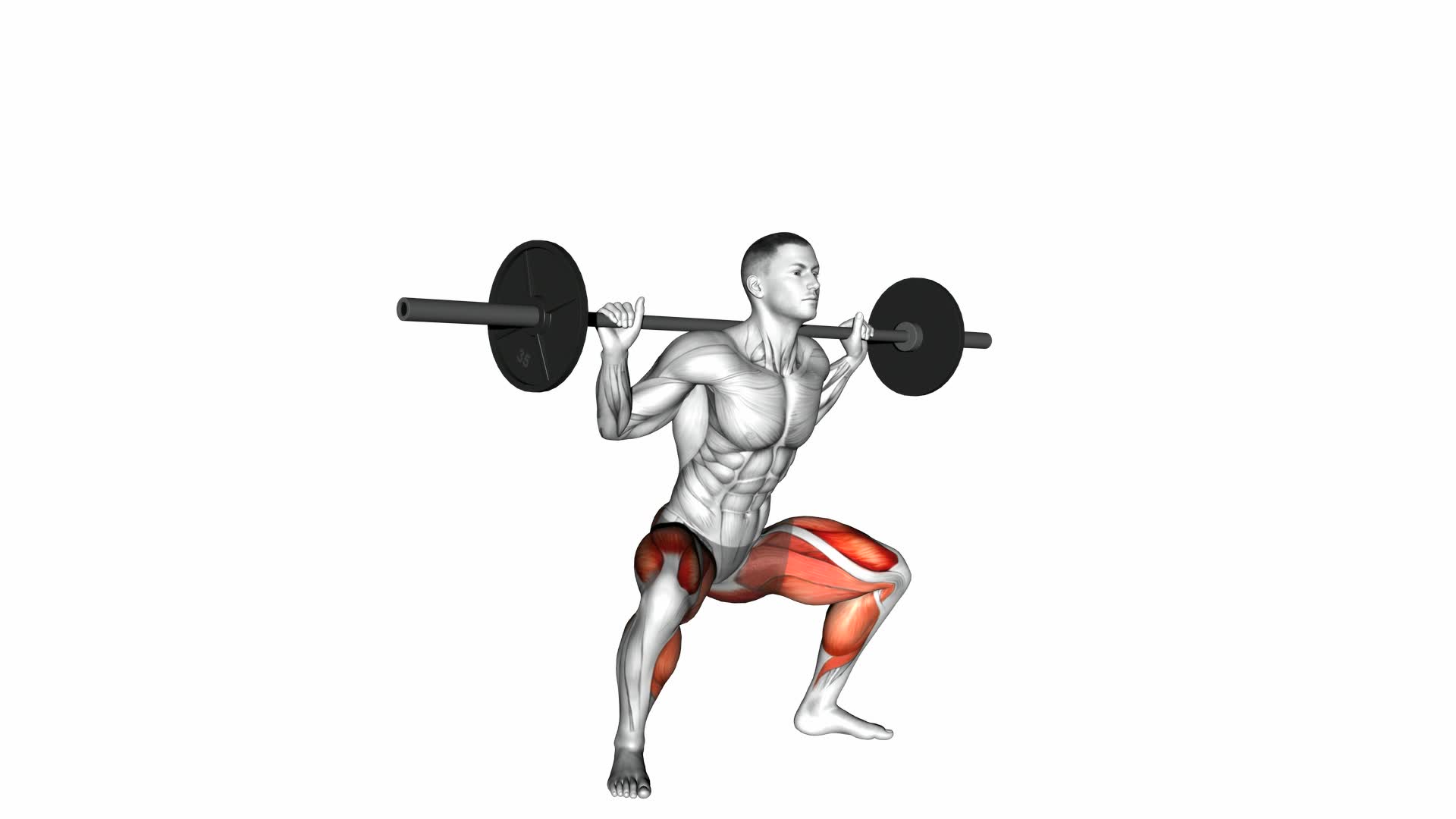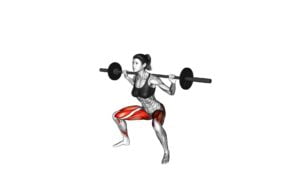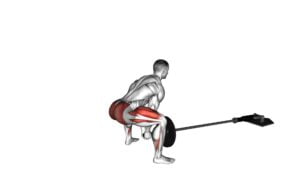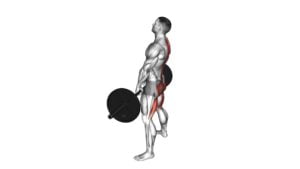Barbell Sumo Squat – Video Exercise Guide & Tips

Are you looking to take your leg workout to the next level? The barbell sumo squat is a powerful exercise that targets your quads, glutes, and hamstrings all at once.
Watch This Exercise Video
In this video exercise guide, we'll show you the proper form and technique to maximize your results. Whether you're a beginner or a seasoned lifter, this exercise can be tailored to your fitness level.
Get ready to feel the burn and see the gains!
Key Takeaways
- The Barbell Sumo Squat targets quads, glutes, and hamstrings while engaging inner thigh muscles.
- It improves hip mobility and flexibility, as well as enhances core stability and balance.
- Choosing the right weight is important, starting with a lighter load and gradually increasing.
- Common mistakes to avoid include focusing on form and technique, avoiding excessive weight that compromises form, and maintaining proper foot and knee alignment.
Benefits of the Barbell Sumo Squat
You can maximize strength and power by incorporating the Barbell Sumo Squat into your workout routine. This exercise, which is a variation of the traditional squat, offers a wide range of benefits that can enhance your overall fitness.
The primary advantage of the Barbell Sumo Squat is its ability to target and strengthen your lower body muscles, particularly your quadriceps, hamstrings, glutes, and calves. The wide stance in this squat variation also engages your inner thigh muscles, helping to build strength and stability in that area.
Additionally, the Barbell Sumo Squat can improve your hip mobility and flexibility, allowing for better range of motion in your workouts. By incorporating this exercise into your routine, you can also enhance your core stability and balance, as it requires you to engage your abdominal muscles to maintain proper form.
These benefits make the Barbell Sumo Squat a valuable addition to any strength training program. Now, let's move on to discuss proper form and technique for this exercise.
Proper Form and Technique
How can you execute the Barbell Sumo Squat with proper form and technique?
To perform the Barbell Sumo Squat correctly, start by standing with your feet wider than shoulder-width apart and toes pointed outward.
Grab the barbell with an overhand grip and position it in front of your body, resting on your upper thighs.
Keep your chest up, core engaged, and back straight as you lower your body down by bending your knees and pushing your hips back.
Make sure your knees track in line with your toes and avoid letting them collapse inward.
Go as low as you can while maintaining proper form, then push through your heels to return to the starting position.
This exercise targets different muscle groups, including the quadriceps, hamstrings, glutes, and inner thighs.
It also helps improve flexibility in the hips and groin area.
As you progress and become comfortable with the exercise, you can gradually increase the weight to challenge your muscles further.
Transitioning to the next section, choosing the right weight, is important to ensure an effective and safe workout.
Choosing the Right Weight
To determine the appropriate weight for the Barbell Sumo Squat, assess your current strength level and choose a load that challenges you without compromising proper form. Choosing the right weight is crucial to ensure you get the most out of this exercise while minimizing the risk of injury.
One common mistake people make is selecting a weight that's too heavy. This can lead to improper technique and poor form, putting unnecessary strain on your muscles and joints. On the other hand, choosing a weight that's too light may not provide enough resistance to effectively engage your muscles and stimulate growth.
To find the right weight, start with a lighter load and gradually increase the weight as you become more comfortable with the exercise. Pay attention to how your body feels during each repetition and adjust accordingly. The weight should be challenging enough that you feel your muscles working, but not so heavy that you sacrifice proper form.
Remember, proper technique is essential for maximizing the benefits of the Barbell Sumo Squat. Keep your feet wider than shoulder-width apart, toes pointing outwards, and maintain a straight back throughout the movement. Engage your core and lower your hips until your thighs are parallel to the floor, then push through your heels to return to the starting position.
Common Mistakes to Avoid
To perform the barbell sumo squat correctly, make sure to focus on your form. Keep your chest up, core engaged, and knees aligned with your toes. Also, avoid using excessive weight that compromises your form and puts unnecessary strain on your joints.
Form Corrections for Sumo Squat
Correcting form is essential for maximizing the effectiveness of your Sumo Squat exercise. To improve your technique and form, there are a few common mistakes you should avoid.
Firstly, make sure your feet are positioned wider than shoulder-width apart, with your toes pointing outwards. This will help activate your glutes and inner thigh muscles effectively.
Secondly, maintain a straight back throughout the movement, avoiding any rounding or arching. Engage your core and keep your chest lifted to ensure proper alignment.
Additionally, ensure that your knees track in line with your toes and don't collapse inward. This will help protect your knees and target the right muscles.
Avoiding Excessive Weight
To avoid excessive weight and prevent injury, it's important to ensure proper form and technique when performing the Barbell Sumo Squat exercise.
One common mistake to avoid is attempting to lift more weight than you can handle. This can put excessive strain on your muscles and joints, increasing the risk of injury.
It's crucial to listen to your body and start with a weight that's challenging but manageable. If you find that the weight is too heavy, consider reducing it or using modifications such as dumbbells or kettlebells instead of a barbell.
This will allow you to maintain proper form and reduce the risk of injury. Remember, it's better to start with a lighter weight and gradually increase as you build strength and confidence in your technique.
Variations and Progressions
To make progress with the barbell sumo squat, you can start by gradually increasing the weight you lift. This will challenge your muscles and help you build strength over time.
Another way to vary the exercise is by trying different stances, such as a wide or narrow sumo squat.
Lastly, you can incorporate resistance bands into your workout to add extra resistance and intensify the exercise.
Increasing Weight Gradually
As you progress in your training, gradually increasing the weight of your barbell sumo squat will help build strength and improve overall performance.
Here are four key ways to incorporate gradual progression and increase the difficulty of your barbell sumo squat:
- Increase the weight incrementally: Start with a weight that challenges you but allows you to maintain proper form. As you become comfortable, gradually add more weight to continue challenging your muscles.
- Adjust the repetitions and sets: Once you can perform the exercise with proper form and ease, increase the number of repetitions or sets. This will add more volume and intensity to your workout, promoting muscle growth and strength.
- Shorten the rest periods: To make the exercise more challenging, reduce the amount of time you rest between sets. This will increase the intensity and keep your muscles engaged throughout the workout.
- Incorporate tempo variations: Experiment with different tempos during your barbell sumo squat. Slow down the lowering phase or pause at the bottom of the squat to add more difficulty and increase time under tension.
Remember to listen to your body and progress gradually to avoid injury and maximize results.
Trying Different Stances
Experimenting with different stances can enhance the effectiveness of your barbell sumo squat and challenge your muscles in new ways. By modifying your technique and trying various stances, you can target different muscle groups and add variety to your workout routine.
One benefit of using a wider stance is that it places more emphasis on your glutes and inner thighs, helping to strengthen and tone these areas. On the other hand, a narrower stance can shift the focus to your quads and hamstrings.
Additionally, you can try elevating your heels with plates or using a staggered stance to further engage your muscles. These variations not only provide different benefits but also prevent your body from adapting to the same movement patterns, promoting continuous progress.
Now, let's explore how incorporating resistance bands can take your barbell sumo squat to the next level.
Incorporating Resistance Bands
To elevate the intensity of your barbell sumo squat and continue challenging your muscles, you can enhance your routine by incorporating resistance bands. Resistance band modifications can add an extra level of resistance and target different muscle groups. Here are four advanced sumo squat variations using resistance bands:
- Resistance Band Sumo Squat Jump: Attach a resistance band around your thighs and perform explosive jumps during the squat, engaging your glutes and quads.
- Resistance Band Sumo Squat Pulse: Loop a resistance band around your thighs and lower into a sumo squat position. Pulse up and down slightly, maintaining tension in the band to work your inner thighs.
- Resistance Band Sumo Squat Walk: Place a resistance band around your ankles and assume a sumo squat position. Take small steps sideways, activating your glutes and outer thighs.
- Resistance Band Sumo Squat with Row: Attach a resistance band to a stable anchor point and hold the other end. As you lower into a sumo squat, perform a row by pulling the band towards your chest, engaging your back muscles.
Incorporating these resistance band modifications into your barbell sumo squat routine will help you build strength, improve stability, and challenge your muscles in new ways.
Tips for Getting the Most Out of Your Workout
To maximize your workout, focus on incorporating these tips into your routine. By following these tips, you can increase your workout efficiency and maximize your results.
Firstly, make sure to warm up properly before starting your workout. This can help prevent injuries and prepare your body for the exercises ahead. Spend a few minutes doing dynamic stretches or light cardio to get your blood flowing and your muscles warmed up.
Next, vary your workouts to avoid hitting a plateau. Your body adapts to the same exercises over time, so it's important to change things up. Incorporate different exercises, intensity levels, and training techniques to keep challenging your muscles and optimize your results.
Another tip is to focus on proper form and technique. Performing exercises with correct form not only reduces the risk of injury but also ensures that you're targeting the right muscles. Take the time to learn the proper form for each exercise and pay attention to your body's alignment and posture.
Additionally, listen to your body and give yourself enough rest and recovery time. Overtraining can lead to fatigue, decreased performance, and increased risk of injury. Schedule rest days in your workout routine and prioritize getting enough sleep to allow your body to repair and rebuild.
Lastly, fuel your body with the right nutrients. Eating a balanced diet that includes protein, carbohydrates, and healthy fats can provide your body with the energy and nutrients it needs to perform at its best.
Frequently Asked Questions
Can the Barbell Sumo Squat Help With Improving Flexibility?
Improving flexibility is one of the benefits of the barbell sumo squat. By performing this exercise, you can target and stretch your hip adductors, hamstrings, and glutes. This can help increase your range of motion and improve your overall flexibility.
The barbell sumo squat is an effective exercise that engages multiple muscle groups and can be incorporated into your workout routine to enhance your flexibility and strength.
Is the Barbell Sumo Squat Suitable for People With Knee or Back Issues?
If you have knee or back issues, the barbell sumo squat may not be suitable for you. It puts a lot of strain on those areas.
However, there are modifications you can make to reduce the impact. You can try using lighter weights or performing the exercise with a kettlebell or dumbbell instead.
Another alternative for knee and back issues is the goblet squat, which places less stress on those areas.
It's important to listen to your body and choose exercises that work best for you.
How Often Should I Incorporate the Barbell Sumo Squat Into My Workout Routine?
To effectively incorporate the barbell sumo squat into your workout routine, it's important to consider your fitness goals and overall program.
The barbell sumo squat is a compound exercise that targets multiple muscle groups, such as the glutes, quads, and hamstrings. It can be beneficial for building lower body strength and power.
Depending on your experience level and recovery abilities, you can include this exercise 1-3 times per week, with proper form and appropriate weights.
What Other Exercises Can I Pair With the Barbell Sumo Squat to Target the Same Muscle Groups?
To improve muscle strength and target the same muscle groups as the barbell sumo squat, you can pair it with exercises like deadlifts, lunges, and hip thrusts. These exercises engage the glutes, quads, and hamstrings, just like the sumo squat.
Additionally, you can try variations of sumo squats, such as goblet squats or dumbbell sumo squats, to add variety to your routine and challenge your muscles in different ways.
Can the Barbell Sumo Squat Help With Improving Athletic Performance in Sports Such as Basketball or Soccer?
To improve your athletic performance in sports like basketball or soccer, the barbell sumo squat can be a valuable exercise. By incorporating this exercise into your training routine, you can work on increasing your lower body strength, which is essential for explosive movements like jumping and sprinting.
The barbell sumo squat targets your quadriceps, glutes, and hamstrings, all of which play a crucial role in improving your vertical jump and overall athletic performance.
Conclusion
In conclusion, the barbell sumo squat is a highly effective exercise for targeting the lower body muscles, including the glutes, quadriceps, and hamstrings. By maintaining proper form and choosing the appropriate weight, you can maximize the benefits of this exercise.
Avoid common mistakes and try variations and progressions to keep challenging your muscles. Remember to follow the provided tips to get the most out of your workout and achieve your fitness goals.

Author
Years ago, the spark of my life’s passion ignited in my mind the moment I stepped into the local gym for the first time. The inaugural bead of perspiration, the initial endeavor, the very first surge of endorphins, and a sense of pride that washed over me post-workout marked the beginning of my deep-seated interest in strength sports, fitness, and sports nutrition. This very curiosity blossomed rapidly into a profound fascination, propelling me to earn a Master’s degree in Physical Education from the Academy of Physical Education in Krakow, followed by a Sports Manager diploma from the Jagiellonian University. My journey of growth led me to gain more specialized qualifications, such as being a certified personal trainer with a focus on sports dietetics, a lifeguard, and an instructor for wellness and corrective gymnastics. Theoretical knowledge paired seamlessly with practical experience, reinforcing my belief that the transformation of individuals under my guidance was also a reflection of my personal growth. This belief holds true even today. Each day, I strive to push the boundaries and explore new realms. These realms gently elevate me to greater heights. The unique combination of passion for my field and the continuous quest for growth fuels my drive to break new ground.



